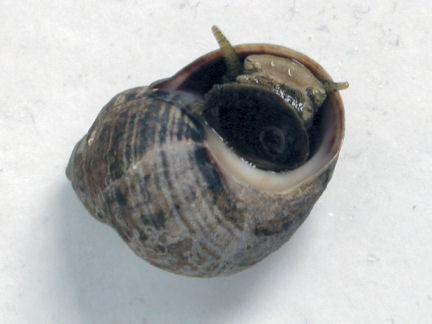Acid snails
Changing chemistry in the world's oceans could affect the ability of a snail to defend itself.
Share this:
- Share via email (Opens in new window) Email
- Click to share on Facebook (Opens in new window) Facebook
- Click to share on X (Opens in new window) X
- Click to share on Pinterest (Opens in new window) Pinterest
- Click to share on Reddit (Opens in new window) Reddit
- Share to Google Classroom (Opens in new window) Google Classroom
- Click to print (Opens in new window) Print
By Emily Sohn
Conditions in the world’s oceans are changing, thanks to human activities. And those changes might be affecting the ability of a small snail to defend itself, suggests a new study.
Factories, cars, and other machines spit out lots of a gas called carbon dioxide. Carbon dioxide (CO2) is known as a greenhouse gas because it traps heat in the atmosphere. More and more of the gas has been accumulating in the air in recent years.
CO2 has also been dissolving in seawater, and that’s been changing the water’s chemical composition. As a result, seawater at the surface of the world’s oceans has become more acidic. That shift could eventually make life tougher for a type of snail called the common periwinkle, say researchers from the University of Plymouth in England.
 |
|
Common periwinkles, like this one, are able to grow thicker shells when predators are near, unless the seawater becomes too acidic.
|
| Simon Rundle |
The common periwinkle lives along coastlines throughout much of Europe. One of its main predators is the common shore crab. The hungry crabs grab the snails “like ice cream cones,” says lead researcher Simon Rundle. Snails with thin shells are most likely to get crushed and eaten.
Scientists already knew that snails grow thicker shells to protect themselves when predators live nearby. The British researchers wanted to know if an increase in the acidity of the water would affect this thickening process.
The scientists grew more than 100 periwinkles in tanks. They put half of the snails in tanks filled with normal seawater. They added CO2 bubbles to the water in the other snails’ tanks to make it acidic. The researchers then put a crab in some of the tanks with both types of water.
In the tanks with normal seawater, the periwinkle shells grew substantially thicker when a crab was living at the bottom. In the tanks with acidic water, the snail shells did not get thicker. These results suggest that snails living in acidic water have a harder time defending themselves from predators.
Scientists measure acidity on what’s called the pH scale. A liquid with a pH of 7, such as distilled water, is considered neutral. A pH measurement of less than 7 indicates acidity. Lemon juice and stomach acid are examples of acidic substances. A pH of greater than 7 is the opposite of acidic, often called basic or alkaline. Bleach is one example.
Overall, the oceans are slightly alkaline, with a pH of 8.2. But studies show that the pH of ocean water has dropped by about 0.1 unit in the past few hundred years. And computer models suggest that ocean pH could drop another 0.3 to 0.4 unit by 2100.
That change could be a problem for all sorts of underwater organisms. As seawater becomes more acidic, these creatures have an increasingly difficult time producing a mineral called calcium carbonate. This material makes up coral reefs, sea urchin teeth, and snail shells, among other structures.
Until now, studies of seawater acidity have mostly looked at its effects on individual species. The new study shows that changes in the oceans are influencing interactions between species, too.
Going Deeper:
Milius, Susan. 2007. Bad acid: Ocean’s pH drop threatens snail defense. Science News 172(Oct. 20):245-246. Available at http://www.sciencenews.org/articles/20071020/fob7.asp .






